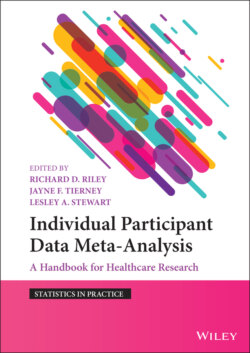Читать книгу Individual Participant Data Meta-Analysis - Группа авторов - Страница 67
Summary Points
ОглавлениеCollecting, checking and managing IPD is more involved and complex than extracting or collecting existing aggregate data, but is fundamental for ensuring that subsequent IPD meta‐analyses are robust and comprehensive.
An IPD meta‐analysis protocol should be registered or published, and include details of: the objectives, eligibility criteria, outcomes to be evaluated and the particular participant‐level covariates to be included or examined; the processes for collecting, coding and checking data and assessing risk of bias, and the statistical methods.
A separate comprehensive statistical analysis plan may also be necessary.
The project should aim to maximise the quantity of high‐quality IPD collected, in order to limit bias and uncertainty of results, and to complete the planned analyses reliably.
Negotiating and maintaining collaboration with trial investigators can take considerable time and effort, but is critical to the success of most IPD projects.
IPD should be transferred and stored securely, and used carefully and appropriately, in order to respect participant confidentiality, whilst also adhering to the data use agreements put in place with the data providers.
Variables contained in the supplied IPD will often need to be re‐coded, re‐defined or derived in a format that is common to all trials, to enable subsequent meta‐analysis.
Data checking is essential to help identify and rectify any major errors, inconsistencies or biases in the IPD, as well as promoting better understanding of individual trials. Such scrutiny may also afford credibility, which may be important for controversial or high‐profile projects.
A detailed log of all changes and transformations made to trial IPD should be maintained, to enable transparency and reproducibility.
Assessment of risk of bias for each trial is initially based on information from trial publications or protocols, supplemented by any information provided by the trial investigator, and is then refined once IPD have been received, checked and cleaned.
Some risk of bias concerns may be alleviated by having the IPD (e.g. inclusion of participants excluded from trial analyses), and others that may only become apparent from checking the IPD (e.g. an allocation pattern indicative of flawed randomisation).
Ultimately, all collaborators will have input into the interpretation and dissemination of results.
It can be helpful to incorporate patient and public involvement and engagement throughout the project, for example, to input into the development of the research questions, and the interpretation and dissemination of results.
